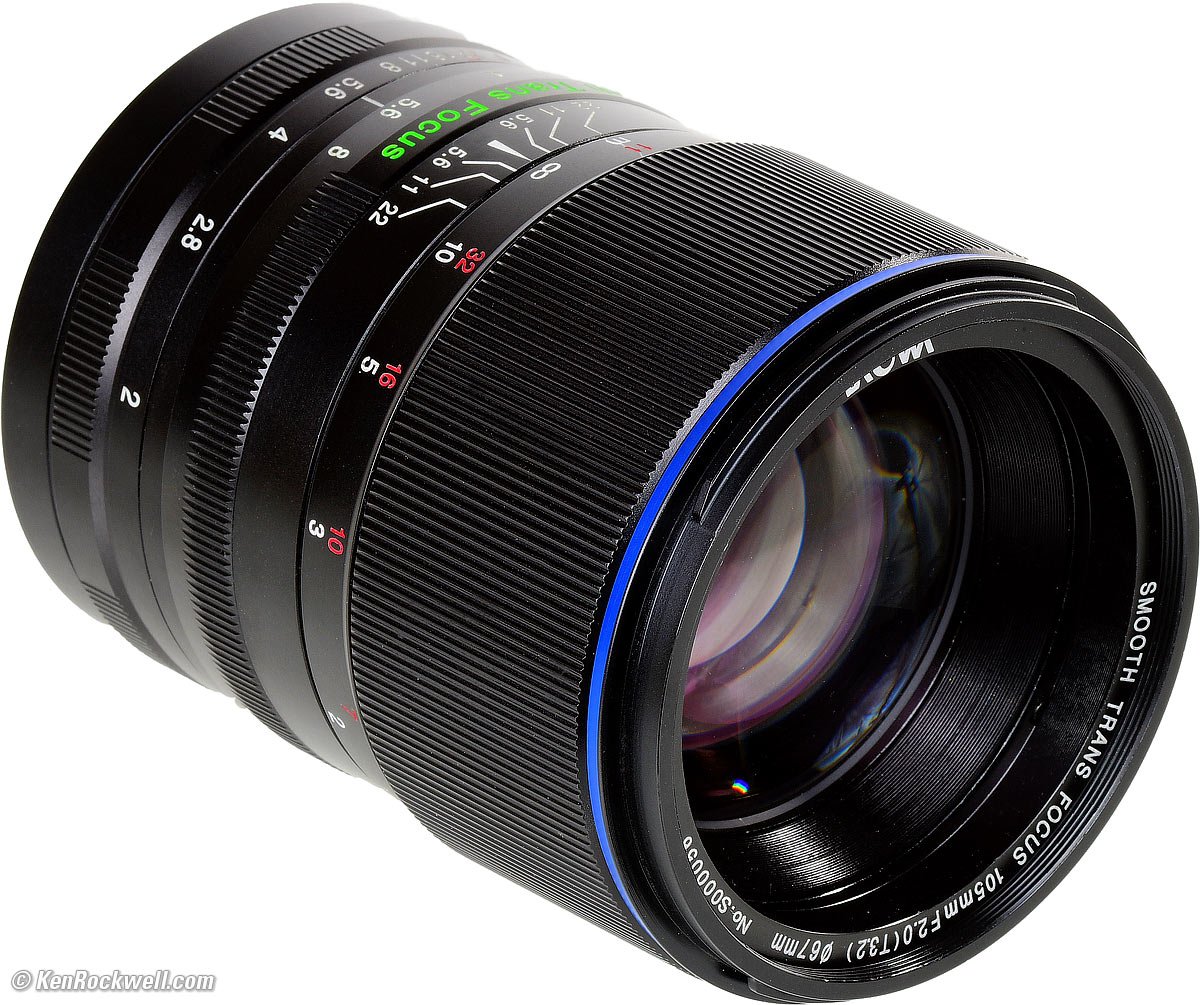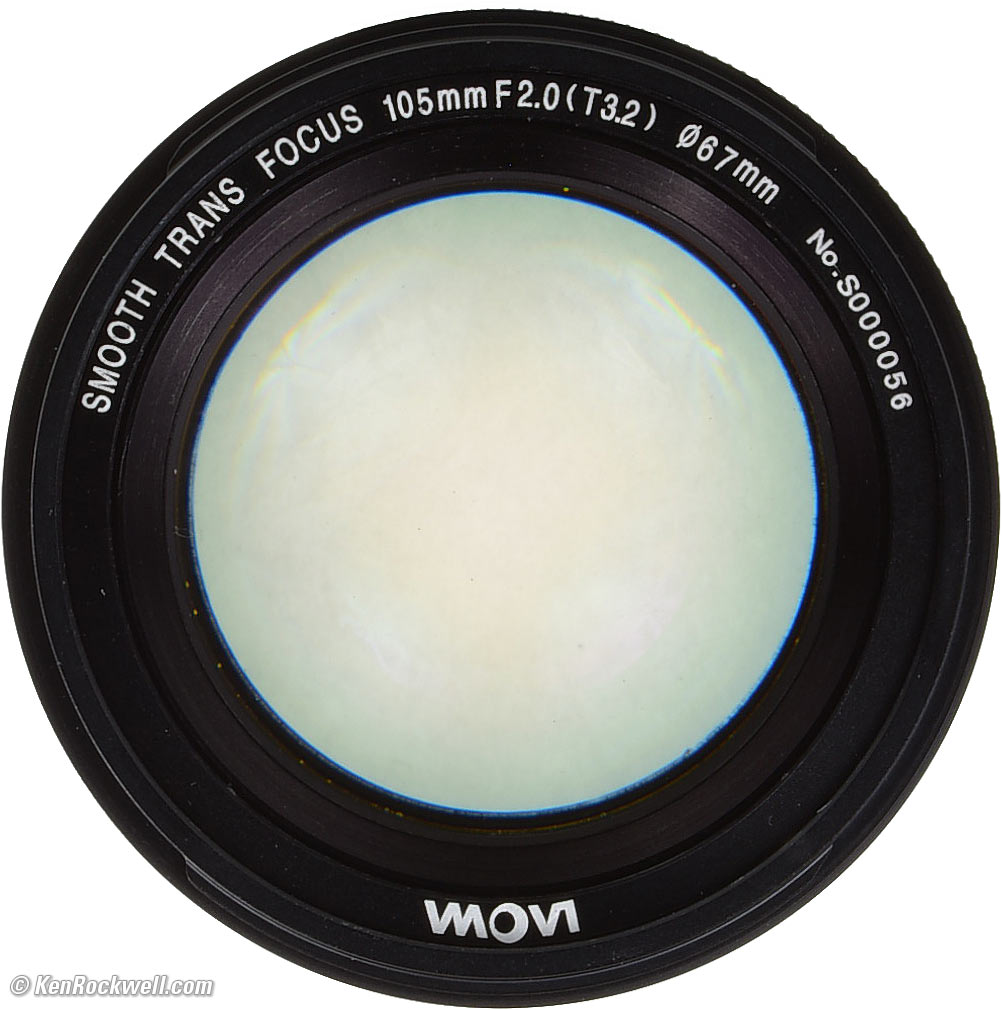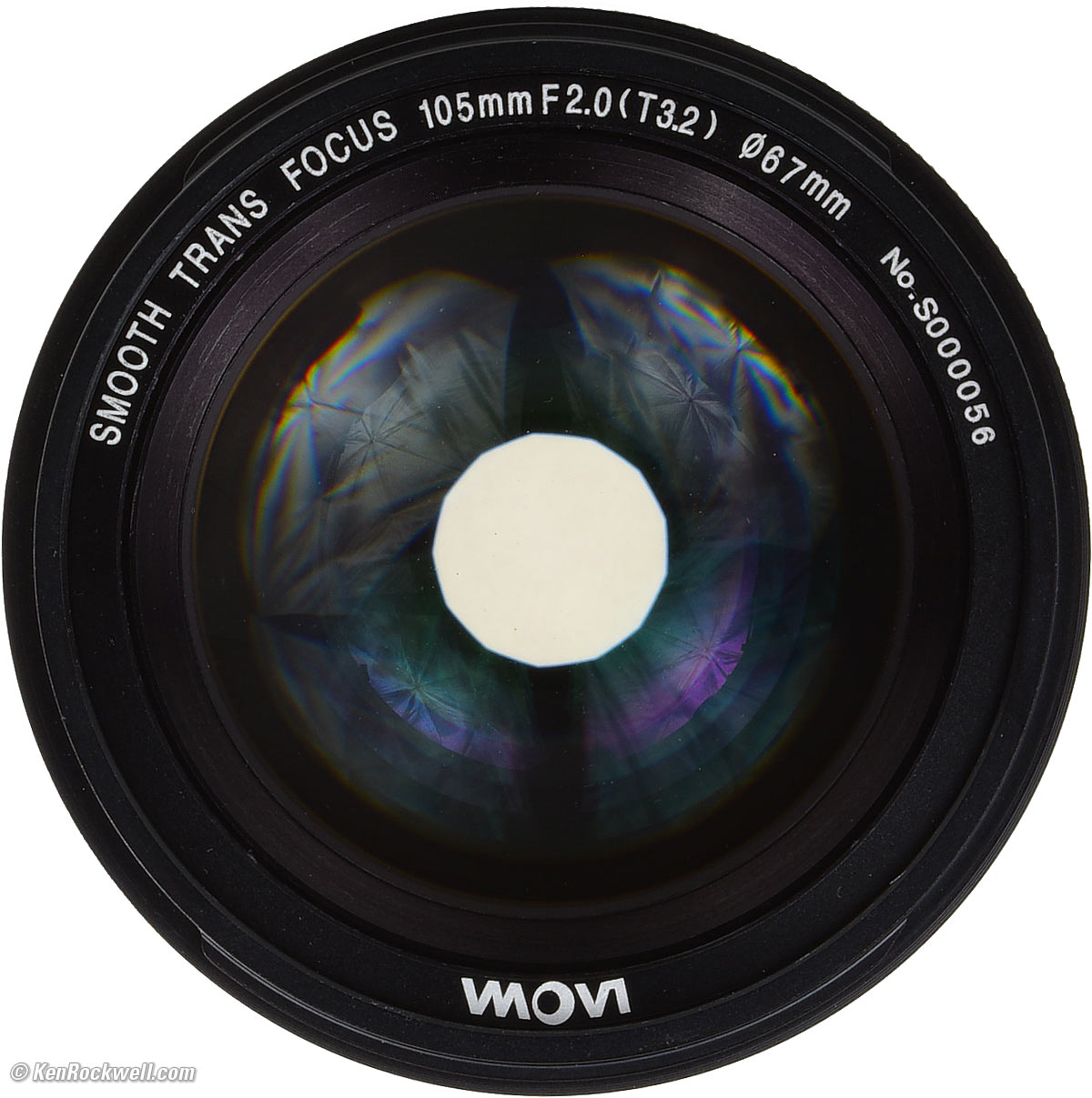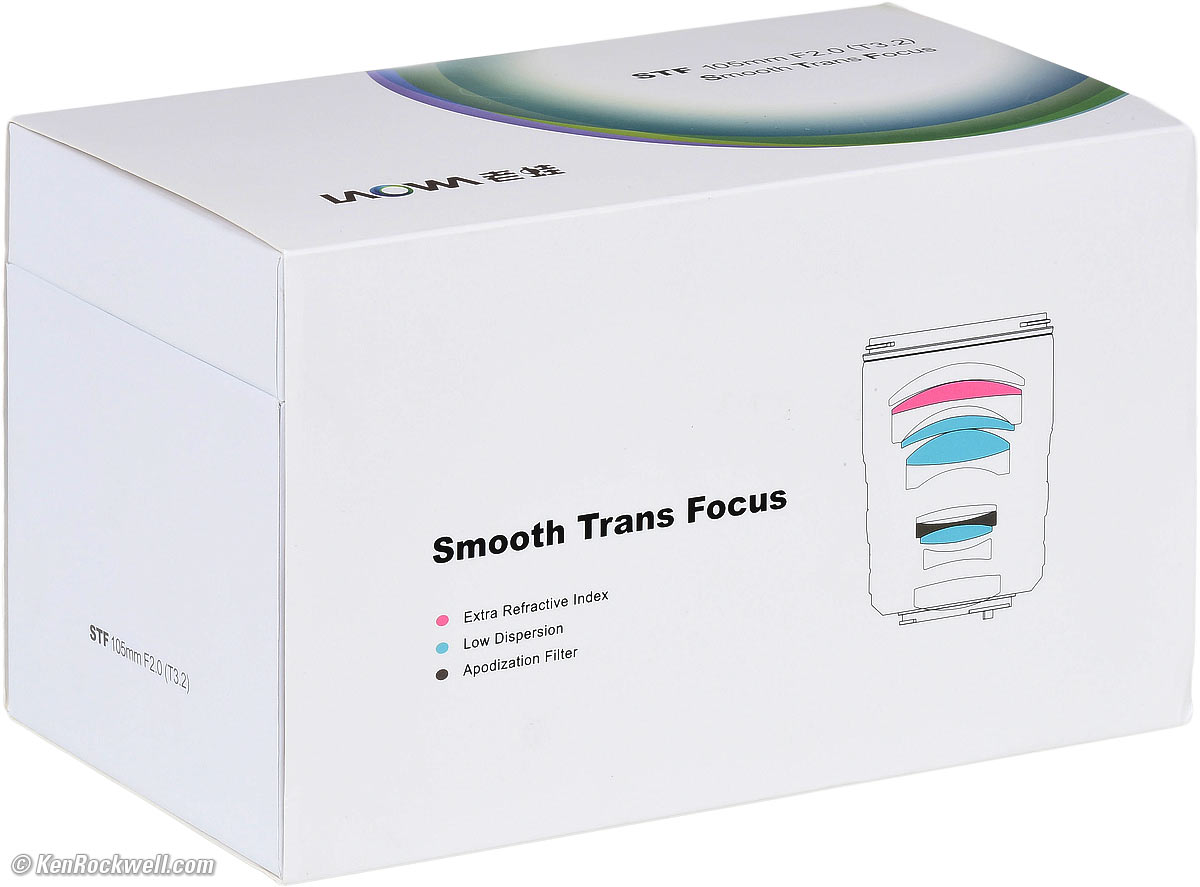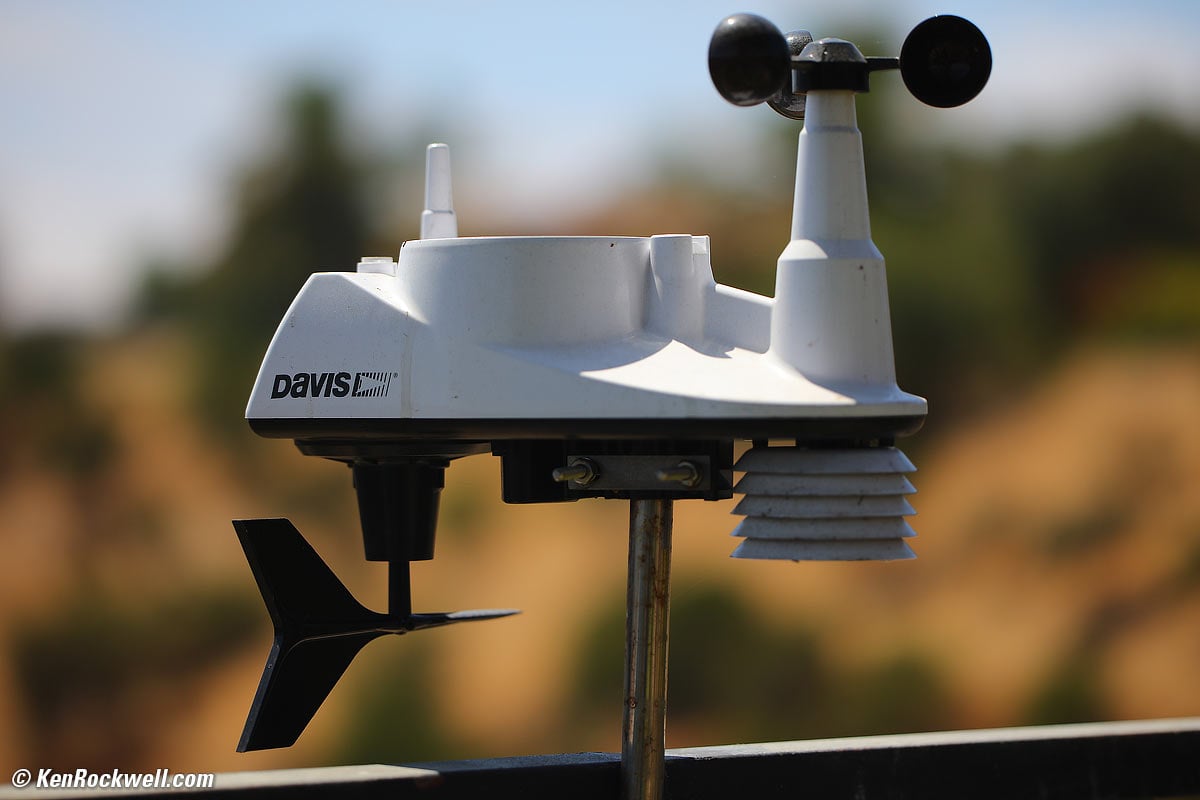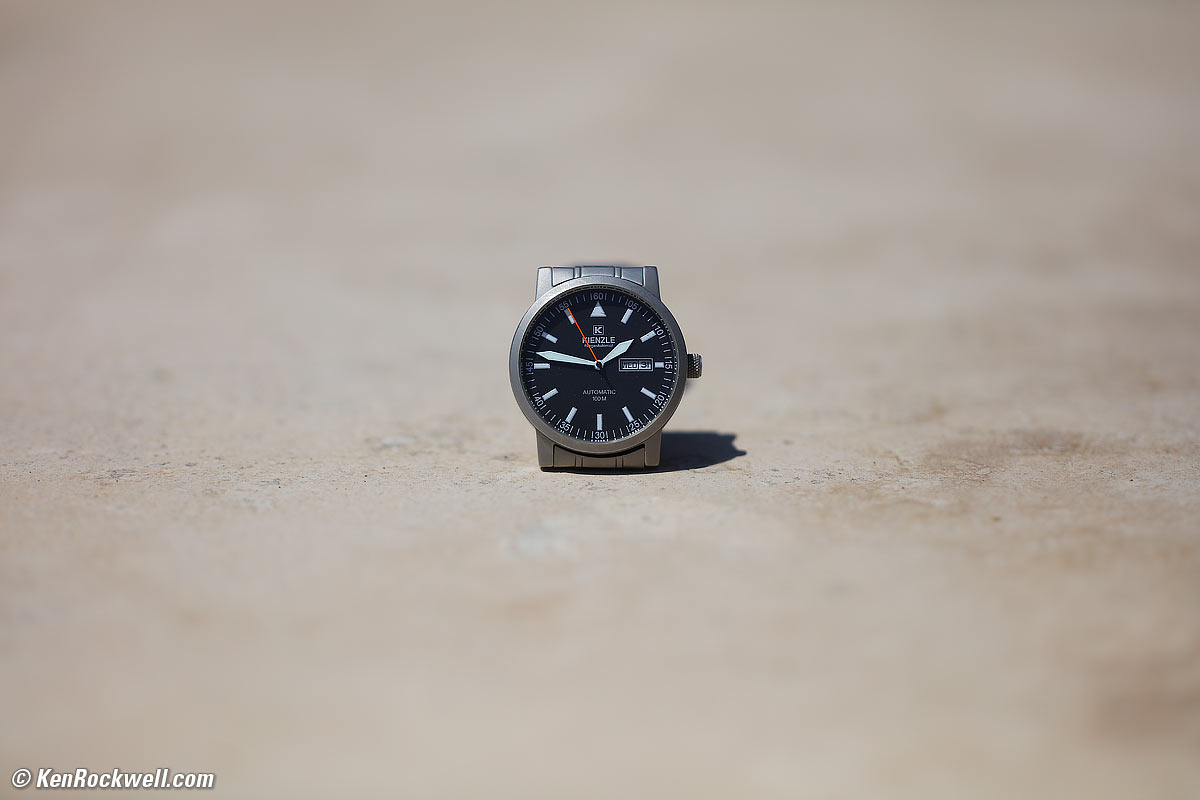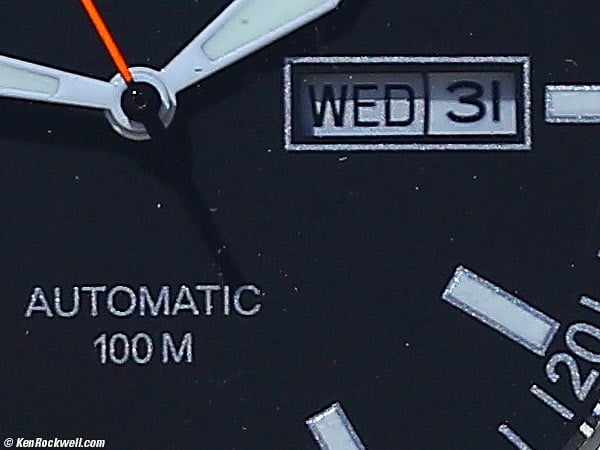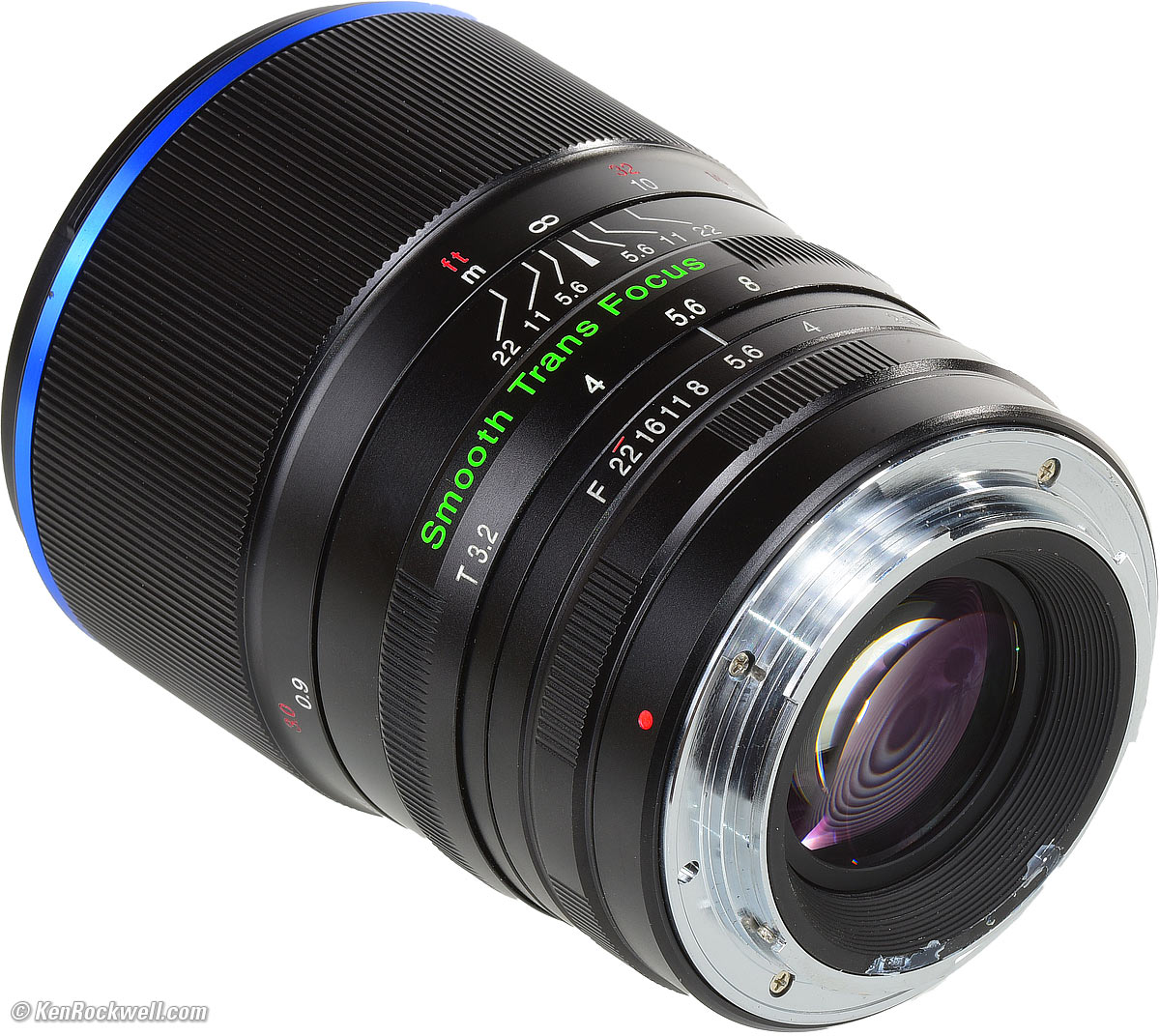Laowa 105mm f/2
T3.2 Smooth Trans-Focus
Top Intro Compatibility Specifications
Performance Usage Recommendations
Venus Optics Laowa 105mm f/2 (T3.2) STF (metal 67mm filter thread, 26.9 oz./763g, about $700) bigger. I'd get it at Adorama, at Amazon for Nikon, at Amazon for Canon or at B&H for Nikon, for Canon, for Sony E-Mount, for Sony A-mount (Minolta MAXXUM) or for Pentax K mount.
This all-content, junk-free website's biggest source of support is when you use those or any of these links to my personally-approved sources when you get anything, regardless of the country in which you live. Buy only from the approved sources I use myself for the best prices, service, return policies and selection. Thanks for helping me help you! Ken.
September 2016 Nikon Canon LEICA Fuji Sony Minolta Zeiss All Reviews
Introduction
Top Intro Compatibility Specifications
Performance Usage Recommendations
|
I buy only from these approved sources. I can't vouch for ads below. |
The Venus Optics Laowa 105mm f/2 (T3.2) is a manual-focus medium telephoto designed for great bokeh. It has superbly sharp optics. This all-metal lens has deliciously smooth backgrounds as well. It's an optical gem, but a completely manual lens.
Bokeh is the quality of out-of-focus backgrounds, and great bokeh means keeping out of focus areas soft and non-distracting. Bad bokeh is when a background is out of focus, but still distracting. (More at What is Bokeh?)
It uses an internal apodization filter to improve the bokeh. This internal filter becomes smoothly darker around its edges to smooth the edges of blur circles.
Fuji makes a similar lens, the 56mm f/1.2 APD, with an apodization filter.
This internal filter of course loses light, so while the lens is f/2 mechanically, the filter blocks enough light so that it only transmits as much light as an ordinary f/3.2 lens. This is why its T-stop (transmission-equivalent stop) is T3.2.
T stops have always been used in cinematography instead of f/stops because they take a lens' light transmission into account for perfect exposure as measured with external light meters. Early single-coated zoom lenses tended to lose so much light that T stops were needed. Most lenses transmit so much light today that T stops are rarely seen outside of cinematography, which standardised on them. On most lenses, the T stop is almost the same as the f/stop.
In case you're still not confused, it has two manual diaphragms, one calibrated in T-stops and the other in f/stops. More on all this at Usage.
It comes in mounts for most cameras.
This is a completely manual mechanical lens. Focus is manual, and the diaphragm is also completely manual, potentiall requiring manual opening and closing for each photo.
This is a lens best used on a tripod or for subjects that don't move.
It is designed and made in China.
Compatibility
Top Intro Compatibility Specifications
Performance Usage Recommendations
This is a completely manual lens.
While it mounts to various cameras, there is no electronic communication and no automatic diaphragm.
There will be no data transfer, so there will be no lens EXIF data for focal length or f/stop.
You have to stop the lens down by hand for each photo unless you're shooting wide-open. It doesn't snap closed by itself as almost all other SLR lenses have done for the past sixty years.
It should work, albeit completely manually, on both 35mm and digital SLRs. Use an adapter and it should work great, again manually, on mirrorless and motion picture cameras.
The Nikon version may have an automatic diaphragm and/or CPU contacts; I have not tried the Nikon version.
Specifications
Top Intro Compatibility Specifications
Performance Usage Recommendations
Name
Venus Optics calls this the Laowa Smooth Trans Focus (STF) 105mm f/2 (T3.2).
Laowa: Venus' brand name for their lenses.
Smooth Trans Focus (STF): The lens has in internal apodization filter that blocks some light, but improves bokeh.
T3.2: At its f/2 setting, it transmits as much light as a conventional lens does at f/3.2.
Optics
11 elements in 8 groups.
3 are extra low dispersion elements.
1 has a high refractive index.
1 apodization filter.
No aspherical elements.
The front and rear groups move separately as focussed inside the barrel; the barrel itself never moves.
The front and rear groups appear to move separately from each other, implying a design which optimizes itself automatically for every focus distance.
The "clear" center of the lens actually has darker edges. These are from the apodization filter. bigger.
Diaphragms
There are two separate completely manual diaphragms, and two separate aperture rings:
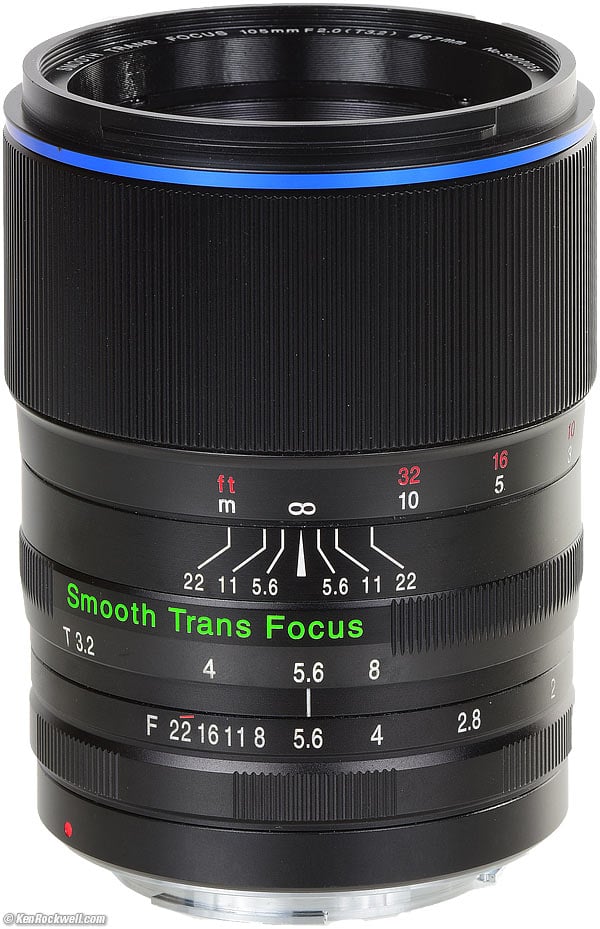 |
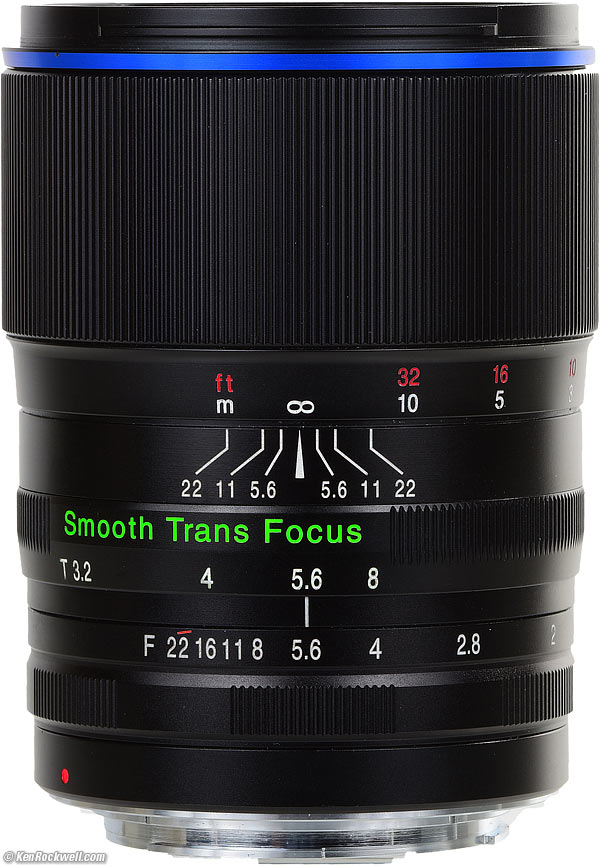 |
105mm f/2 T3.2 STF. bigger. |
105mm f/2 T3.2 STF. bigger. |
There is no automatic diaphragm that snaps down to taking aperture; you have to open and close it manually to focus or to shoot.
Venus Optics Laowa 105mm f/2 T3.2 STF at f/5.6. bigger.
13 blades as seen above (Laowa says 9 blades).
Stops down to f/22.
Full-stop clicks, OK to set any in-between setting.
T Stops
14 blades.
Stops down to T8.
There are no clicks, just continuous setting.
Focal Length
105mm.
When used on Nikon DX cameras, it sees the same angle of view as a 160 mm lens sees when used on a 35mm or full-frame camera.
When used on Canon APS-C cameras, it sees the same angle of view as a 170 mm lens sees when used on a 35mm or full-frame camera.
See also Crop Factor.
Angle of View
23.27º diagonal on full-frame.
Close Focus
3 feet (0.9 meters).
Maximum Reproduction Ratio
1:6.3 (0.16 ×).
Filters
Metal 67 mm filter thread.
Hood
Plastic hood included.
Case
None included.
Size
3.99" maximum diameter × 3.89" extension from flange.
76 mm maximum diameter × 98.9 mm extension from flange.
Weight
26.925 oz. (763.3 g) actual measured weight, Canon version.
Rated 26.3 oz. (745g); will vary with mount.
Included
Lens.
Plastic hood.
What appears to be an original Canon rear cap and a Nikon-style generic front cap (Canon version).
Packaging
Venus Optics Laowa 105mm f/2 T3.2 STF. bigger.
Slip sleeve covering a nice cardboard box wrapped in nice paper.
Black open-cell foam cut to fit the lens.
Price, USA
$700, September 2016.
Performance
Top Intro Compatibility Specifications
Performance Usage Recommendations
Overall Focus Bokeh Distortion Falloff Exposure
Ergonomics Macro Mechanical Quality Sharpness
Overall
This 105mm lens has superb sharpness, bokeh and has no distortion, but demands completely manual operation.
Focus
Focus is completely manual.
Turn the ring until the image is sharp either on your screen, or in Live View.
Autofocus Nikon cameras will have electronic focus aids in the finder.
There is no chip for Canon, so Canon cameras will have no in-finder focus confirmation lights. Use Live View, or just turn the ring until the image is sharp on the ground glass.
Bokeh
Bokeh, the feel or quality of out-of-focus areas as opposed to how far out of focus they are, is marvelous. Backgrounds just melt away without distracting edges.
Davis 6250 weather station, 31 August 2016. Canon 5DSR, f/2 (T3.2) at 1/2,500 at ISO 100. bigger or camera-original © file to explore on your computer (mobile devices rarely display full resolutions images properly).
Distortion
There is no measurable distortion, as measured at 3 meters (10 feet).
Falloff
Falloff on FX and 35mm is minor. While it might look scary on the gray targets below, in actual shooting it's minor at f/2 and invisible by f/2.8.
It shouldn't be an issue at all on DX (see crop factor).
I've exaggerated this by shooting a gray field and placing these on a gray background.
Laowa 105mm f/2 STF falloff on FX and 35mm at infinity, no correction:
© 2016 KenRockwell.com. All rights reserved. |
Exposure
Since it probably has no connection to your metering system depending on camera brand, exposure may be automatic, but often may require manual compensation.
This is because you are probably not going to get the advanced multi-segment metering we take for granted with camera-brand lenses, and worse, since your camera's meter may go half nuts from the lack of a data connection (no electronic contacts on the lens), manual and auto exposure may be off a stop or two.
No worries, just know that this is normal and expect to dial-in whatever compensation is needed to get the right exposure. This will vary with aperture setting and conditions.
Ergonomics
This all-metal mechanical lens reminds me of 1970s Japanese third-party lenses: it's all anodized aluminum with engraved markings. It's a solid all-metal lens; there is no plastic. It's tough and simple.
It's easy to handle, with its big metal focus ring and two big aperture rings, but you will be needing to fiddle with these for each and every shot. There is no automatic anything.
In fact, you will have to open the diaphragm to focus, and then close it down to taking aperture manually for each shot. There is no automatic diaphragm as all other SLR lenses have had since 1965; these are completely manual diaphragms.
 |
 |
105mm f/2 T3.2 STF. bigger. |
105mm f/2 T3.2 STF. bigger. |
Macro
This is not a macro lens. It gets about as close as every other portrait lens:
Kienzle Flieger Automat 800/2843, 31 August 2016 at close-focus distance on full-frame. Canon 5DSR, f/2 (T3.2) at 1/8,000 at ISO 100. bigger or camera-original © file to explore on your computer (mobile devices rarely display full resolution images properly).
It doesn't get that close, but it is ultra-sharp even wide-open:
600-pixel crop from above file. Canon 5DSR, f/2 (T3.2) at 1/8,000 at ISO 100. camera-original © file to explore on your computer (mobile devices rarely display full resolution images properly). If this is about 6" (15cm) wide on your screen, then the complete image at this same high magnification would be a 60 x 90" (1.5 x 2.2 meter) print!
If you need macro with this lens, use extension tubes.
Mechanical Quality
Venus Optics Laowa 105mm f/2 T3.2 STF. bigger.
It's all metal, and all the markings are engraved.
All the barrel markings appear to be deeply engraved with a router — the expensive old-fashioned way LEICA does.
The identity ring around the front of the lens with the serial number seems to be laser-engraved.
This is a solid lens. Don't tell anyone, but when I unpacked mine I dropped it 4 feet (1.2 meters) onto a hardwood floor (wood panel over concrete) and it was fine. The reversed hood and caps probably helped protect it; and it bounced off the floor without a dent or scratch.
Sharpness
It's super-sharp. Even wide-open in the corners of my 50 megapixel Canon 5DSR it's still super sharp. There is the tiniest bit of red-blue lateral color at the sides at 50 MP, but it's too minor to notice in actual photos and Nikon cameras correct this automatically. There are no dedicated profiles for Canon cameras.
This lens has essentially perfect optics. Its only limitations are your skill as a photographer.
Usage
Top Intro Compatibility Specifications
Performance Usage Recommendations
Overall
This lens has no electronic coupling to your camera. Do not expect any electronic focus indications, any EXIF data, or any meaningful exposure or aperture information in your viewfinder. Do not expect consistent auto exposure. You probably can get auto exposure in Av mode on Canon or A mode on Nikon, but expect to have to add exposure compensation that will vary by the aperture and light conditions.
Focus
Use Live view if you need perfection.
Otherwise I got surprisingly excellent results simply by looking at my ground glass.
Focus wide open at f/2 (T3.2) and then stop down to taking aperture.
Apertures
T-stops, or "transmission" stops, mean that a lens transmits the same light as a perfect lens at the same f/stop. All lenses have T-stops slightly less than their f/stops because their glass doesn't transmit 100% of the light.
Most lenses today transmit between 90% and 99% of the light, so the T stop is essentially the same as the f/stop.
When you add the gray apodization filter inside this lens, it only transmits about 39% of the light, so when set to f/2 (wide open), this lens gives the same exposure as a normal f/3.2 lens.
There are two aperture rings. Use only one at a time; leave the other wide open at f/2 or T3.2.
Either ring may be set to any setting between markings.
The f/stop ring has clicks at each stop down to f/22.
The T-stop ring has no clicks and goes to T8.
The T-stop ring is intended for cinematography.
If using an external meter, use the T-stop ring and treat it as calibrated f/stops for exposure; that's what a T-stop is. If your hand-held meter says f/5.6 at 1/250, set T5.6, not f/5.6.
Most of us buy this lens for its superb bokeh, in which case we of course want to shoot it wide open at f/2 (T3.2). Set both rings this way.
Otherwise, use whichever ring you like. I'd use the T-stop ring if you want the exposures to make sense with an external meter, and the f/stop ring if you need the smaller apertures.
Recommendations
Top Intro Compatibility Specifications
Performance Usage Recommendations
This lens has superb bokeh. Backgrounds melt away and the subjects are ultra sharp with no worries from spherochromatism (colored bokeh), however operation is horridly clumsy and manual.
If you like to use lenses on adapters and enjoy the manual process, or if you shoot on a tripod, you'll probably love this lens.
If you expect autofocus, auto exposure, EXIF data, meaningful viewfinder information and a diaphragm that works without having to be adjusted manually on a constant basis, forget this lens and get the Canon EF 100mm f/2 for Canon, or the Nikon 105mm f/2 DC for Nikon, either of which are also superior lenses that also operate fully automatically.
Filters
The very best protective filter is the 67mm Hoya multicoated HD3 UV which uses hardened glass and repels dirt and fingerprints, and is also multicoated.
For less money, the B+W 67mm 010 is an excellent filter, as are the multicoated version and the basic multicoated Hoya filters, but the Hoya HD3 is the toughest and the best.
Filters last a lifetime, so you may as well get the best. The Hoya HD3 stays cleaner than the others since it repels oil and dirt.
Where to get it
I'd get it at Adorama, at Amazon for Nikon, at Amazon for Canon or at B&H for Nikon, for Canon, for Sony E-Mount, for Sony A-mount (Minolta MAXXUM) or for Pentax K mount.
This all-content, junk-free website's biggest source of support is when you use those or any of these links to approved sources when you get anything, regardless of the country in which you live. I use the stores I do because they ship from secure remote warehouses where no one gets to touch your new camera before you do. Buy only from the approved sources I use myself for the best prices, service, return policies and selection.
Thanks for helping me help you!
Ken, Mrs. Rockwell, Ryan and Katie.
© Ken Rockwell. All rights reserved. Tous droits réservés. Alle Rechte vorbehalten.
Help Me Help You
I support my growing family through this website, as crazy as it might seem.
The biggest help is when you use any of these links when you get anything. It costs you nothing, and is this site's, and thus my family's, biggest source of support. eBay is always a gamble (see How to Win at eBay), but all the other places always have the best prices and service, which is why I've used them since before this website existed. I recommend them all personally.
If you find this page as helpful as a book you might have had to buy or a workshop you may have had to take, feel free to help me continue helping everyone.
If you've gotten your gear through one of my links or helped otherwise, you're family. It's great people like you who allow me to keep adding to this site full-time. Thanks!
If you haven't helped yet, please do, and consider helping me with a gift of $5.00.
As this page is copyrighted and formally registered, it is unlawful to make copies, especially in the form of printouts for personal use. If you wish to make a printout for personal use, you are granted one-time permission only if you PayPal me $5.00 per printout or part thereof. Thank you!
Thanks for reading!
Mr. & Mrs. Ken Rockwell, Ryan and Katie.

